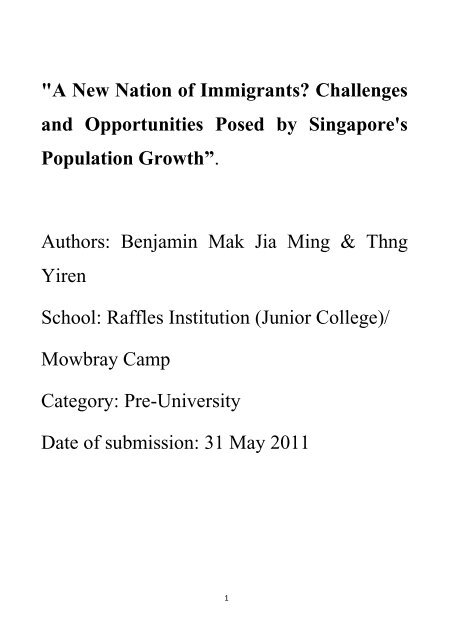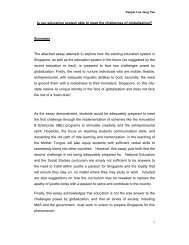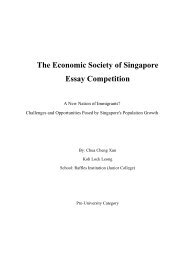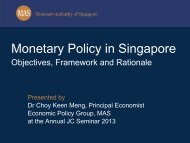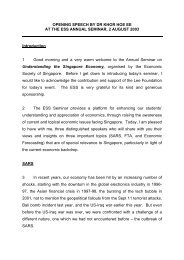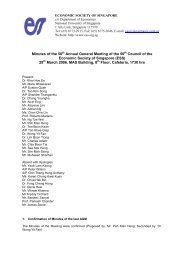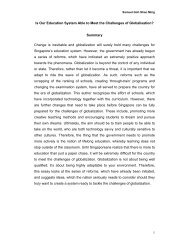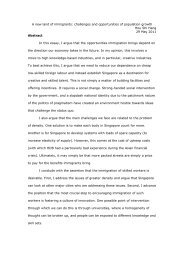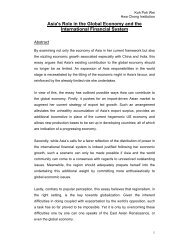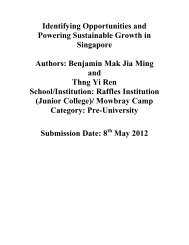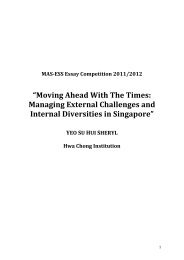Benjamin Mak and Thng Yi Ren - Economic Society of Singapore
Benjamin Mak and Thng Yi Ren - Economic Society of Singapore
Benjamin Mak and Thng Yi Ren - Economic Society of Singapore
- No tags were found...
You also want an ePaper? Increase the reach of your titles
YUMPU automatically turns print PDFs into web optimized ePapers that Google loves.
"A New Nation <strong>of</strong> Immigrants Challenges<br />
<strong>and</strong> Opportunities Posed by <strong>Singapore</strong>'s<br />
Population Growth”.<br />
Authors: <strong>Benjamin</strong> <strong>Mak</strong> Jia Ming & <strong>Thng</strong><br />
<strong>Yi</strong>ren<br />
School: Raffles Institution (Junior College)/<br />
Mowbray Camp<br />
Category: Pre-University<br />
Date <strong>of</strong> submission: 31 May 2011<br />
1
Executive Summary<br />
Population growth is a long-st<strong>and</strong>ing concern in <strong>Singapore</strong> with its dwindling birth rate, <strong>and</strong><br />
immigration has been viewed as one <strong>of</strong> the most crucial ways for <strong>Singapore</strong> to sustain a dynamic<br />
workforce <strong>and</strong> economy. This essay supports the broad thesis that immigration adds to both the<br />
quality <strong>and</strong> quantity <strong>of</strong> <strong>Singapore</strong>‟s growth. However, we suggest that immigration must be<br />
complemented by a parallel improvement in <strong>Singapore</strong>an labour <strong>and</strong> capital in order to prevent its<br />
benefits from being overshadowed by the increasingly negative sentiments <strong>Singapore</strong>ans have<br />
expressed towards immigrants. Furthermore, we argue that <strong>Singapore</strong>‟s immigration policy must<br />
continue to be selective to ensure that the right talents are attracted in the appropriate quantity such<br />
that the net benefit brought by any single immigrant should not be outweighed by the costs this<br />
immigrant may impose on the rest <strong>of</strong> society.<br />
When combined with a drive to promote labour productivity <strong>and</strong> mobility among lesseducated<br />
<strong>Singapore</strong>ans, an Export-Import bank to fuel local business expansion overseas <strong>and</strong><br />
initiatives to support the optimal distribution <strong>of</strong> top talents across the public <strong>and</strong> private sector, we<br />
argue that immigration-led population growth can lead to a win-win situation rather than mutual<br />
antagonism between immigrants <strong>and</strong> <strong>Singapore</strong>ans.<br />
Nevertheless, this essay acknowledges a strong non-economic dimension to immigration<br />
because it poses a fresh challenge to our national character, immigrant nation as we may be.<br />
<strong>Economic</strong>ally speaking, immigration has contributed to wage depression for lower-income earners<br />
<strong>and</strong> increased competition in the labour market especially for inexperienced graduates. This essay<br />
acknowledges that such challenges cannot be overcome fully unless immigration is eliminated, but<br />
suggests that they can be sufficiently mitigated with the adoption <strong>of</strong> the aforementioned policy<br />
recommendations. Ultimately though, the question <strong>of</strong> immigration is not one <strong>of</strong> absolutes: it is one<br />
<strong>of</strong> balancing economic goals against social needs in charting <strong>Singapore</strong>‟s destiny.<br />
Word count: 300<br />
2
Introduction<br />
‘The most superficial student <strong>of</strong> Roman history must be struck by the extraordinary degree in which<br />
the fortunes <strong>of</strong> the republic were affected by the presence <strong>of</strong> foreigners, under different names, on<br />
her soil.’<br />
Henry James Summer Maine<br />
As <strong>Singapore</strong> recovers from the 2008 financial meltdown, we are again confronted with the<br />
challenge <strong>of</strong> immigration, a demographic trend that has buttressed our economic growth but raised<br />
fresh questions about our national identity. With sustained effort to develop <strong>Singapore</strong>an enterprises<br />
<strong>and</strong> talent however, this essay confutes the canard that immigration <strong>and</strong> socio-economic well-being<br />
are mutually exclusive over the long run.<br />
Perceived challenges from immigration<br />
<strong>Singapore</strong>ans <strong>of</strong>ten view immigrants as threats to their well-being. This was made starkly clear in<br />
the angry petition from residents <strong>of</strong> Serangoon Gardens in 2008 against the construction <strong>of</strong> a new<br />
foreign workers‟ dormitory near their homes 1 .<br />
Although there is strong empirical evidence that immigrants add value to <strong>Singapore</strong>‟s economy,<br />
immigration is <strong>of</strong>ten associated with concentrated benefits <strong>and</strong> diffuse costs 2 . While businesses <strong>and</strong><br />
the government reap rewards from immigration through cheaper labour <strong>and</strong> higher taxes, the burden<br />
<strong>of</strong> accepting immigrants here is placed upon society, making it difficult for ordinary <strong>Singapore</strong>ans<br />
to see how they benefit personally from immigration.<br />
Following the watershed 2011 elections, the government has emphasised the need to review policies<br />
across the board. While this is broadly accurate, there remain two myths surrounding immigration<br />
that must be dispelled to clarify the true significance <strong>of</strong> immigration for <strong>Singapore</strong>‟s economy.<br />
1 See Forss (2008)<br />
2 Olson (1965)<br />
3
Myth 1: Foreigners Spur Inflation<br />
Foreigners are <strong>of</strong>ten accused <strong>of</strong> promoting dem<strong>and</strong>-pull inflation, driving the prices <strong>of</strong> housing <strong>and</strong><br />
other necessities up. Proponents <strong>of</strong> this view cite the fact that in the first half <strong>of</strong> 2010, foreign<br />
purchases accounted for about 25% <strong>of</strong> the total residential property sales transactions 3 .<br />
Ins<strong>of</strong>ar as the primary housing market <strong>Singapore</strong>ans are concerned with is Housing Development<br />
Board (HDB) housing however, such arguments are groundless. Under HDB policy, only<br />
<strong>Singapore</strong>an Citizens or Permanent Residents can buy Build-to-Order (BTO) Flats or resale flats.<br />
Since the bulk <strong>of</strong> foreign purchases are concentrated in private property, they cannot be held<br />
responsible for the recent public housing bubble.<br />
Similarly, attributing overall inflation primarily to foreigners is mistaken, due to the confluence <strong>of</strong><br />
exogenous factors including seasonal variations <strong>and</strong> oil price shocks depicted below 4 .<br />
Chart 1<br />
This diagram illustrates the contributors to inflation in <strong>Singapore</strong> in early 2011.<br />
3 See Global Property Guide (2010).<br />
4 Monetary Authority <strong>of</strong> <strong>Singapore</strong> (2011)<br />
4
Myth 2: Foreigners steal <strong>Singapore</strong>an jobs<br />
Since foreigners took up 48% <strong>of</strong> the total number <strong>of</strong> new jobs created between 1998 <strong>and</strong> 2008 5 ,<br />
many argue that <strong>Singapore</strong>ans are squeezed out <strong>of</strong> the job market at both the top <strong>and</strong> bottom tiers <strong>of</strong><br />
employment by foreign talent <strong>and</strong> foreign workers, suggesting that <strong>Singapore</strong>ans are uncompetitive<br />
in terms <strong>of</strong> skills <strong>and</strong> wages respectively.<br />
Under close scrutiny though, this view is unfounded. In both middle- <strong>and</strong> top-tiered jobs, Finance<br />
Minister Tharman Shanmuguratnam reported that 80% <strong>of</strong> managerial positions are now held by<br />
<strong>Singapore</strong>ans in a Channelnewsasia political forum aired on 2 April 2011. Furthermore, when firms<br />
hire foreigners at the Integrated Resorts while suitable local talent is being sourced for <strong>and</strong> trained<br />
for example, <strong>Singapore</strong>ans will eventually benefit from enhanced employment opportunities.<br />
Immigration: the real concerns<br />
‘Wealth is not his that has it, but his that enjoys it’<br />
<strong>Benjamin</strong> Franklin<br />
Nevertheless, there are genuine challenges for <strong>Singapore</strong>‟s economy upon deeper examination <strong>of</strong><br />
immigration-led population growth. First, most immigrants were employed in lower-skilled jobs 6 ,<br />
precipitating wage depression for lower-income <strong>Singapore</strong>ans, with real median monthly incomes<br />
<strong>of</strong> the bottom 20% <strong>of</strong> employed residents by income being static from 1996 to 2009 7 . Though we<br />
cannot isolate the individual contributions <strong>of</strong> the multifarious factors contributing to wage<br />
depression, including „new technologies, the decline in manufacturing jobs, drop in unionization,<br />
globalization <strong>and</strong> recessions‟ 8 , this is worrying because most <strong>of</strong> our lower-income workers tend also<br />
to be part <strong>of</strong> the rapidly ageing segment <strong>of</strong> our society. It is also striking that the educational level<br />
<strong>of</strong> unemployed <strong>Singapore</strong>ans has risen steadily over time. Whereas managers, pr<strong>of</strong>essionals <strong>and</strong><br />
technicians formed just 7.6% <strong>of</strong> unemployed residents in 1976, this figure nearly quadrupled to<br />
30.3% by 2003 9 . Inasmuch as population growth has raised <strong>Singapore</strong>‟s wealth, it remains doubtful<br />
as to whether most <strong>Singapore</strong>ans feel this.<br />
5 See Hui, Weng Tat. “Rethinking <strong>Singapore</strong>'s Social Safety Nets .” 2010. Civil Service College, <strong>Singapore</strong>. p.1<br />
6 Ibid., p. 2.<br />
7 See Hui (2004).<br />
8 See Henderson (2011).<br />
9 See Hui (2004), p. 82<br />
5
Immigrants: An Enduring Vista <strong>of</strong> Hope<br />
Having foreign workers, talents etc in <strong>Singapore</strong> is not new. We have always been open to those<br />
who come to our shores to seek a living or to make this place home.<br />
Tan Chuan-Jin,<br />
Minister <strong>of</strong> State for Manpower <strong>and</strong> National Development<br />
Though <strong>Singapore</strong>‟s economy now focuses on services <strong>and</strong> high-technology research, it remains<br />
constrained by geography <strong>and</strong> demography. Thus, the main benefit presented by <strong>Singapore</strong>‟s<br />
immigration-led population growth arises from its ability to promote a dynamic economy.<br />
Indeed, <strong>Singapore</strong> has excelled in attracting talented immigrants to lead new engines <strong>of</strong> growth,<br />
most notably in the biomedical sector where such luminaries as Pr<strong>of</strong>essor Sir David Lane oversaw<br />
the recruitment <strong>of</strong> top cancer researchers Neal Copel<strong>and</strong> <strong>and</strong> Nancy Jenkins as Executive Director<br />
<strong>of</strong> the Institute <strong>of</strong> Molecular <strong>and</strong> Cell Biology in 2006 10 . <strong>Economic</strong>ally speaking, immigration has<br />
left an indelible imprint in <strong>Singapore</strong>‟s success. From 2000 to 2010, foreigners contributed around<br />
40% <strong>of</strong> our GDP measured in terms <strong>of</strong> domestic output 11 <strong>and</strong> comprised 40% <strong>of</strong> our labour force in<br />
2006 12 .<br />
Such success can be attributed to <strong>Singapore</strong>‟s selective immigration policy which ensures „an<br />
increased inflow <strong>of</strong> middle aged, high- <strong>and</strong> medium-skilled immigrants‟ based on careful<br />
assessments <strong>of</strong> the „net public gain <strong>of</strong> a marginal immigrant‟ 13 . Hence, <strong>Singapore</strong> should merely<br />
fine-tune its immigration policy if necessary to continue gaining maximal benefit from new<br />
immigrants, rather than seek fundamental changes.<br />
10 Agency for Science, Technology & Research (2009)<br />
11 See Lim & Lee (2010), p. 146.<br />
12 Ibid., p. 145.<br />
13 See Storesletten (2000).<br />
6
Strategies for the long run<br />
Perhaps the fact that Mr Tharman Shanmugaratnam now coordinates both economic <strong>and</strong> social<br />
policies highlights the dualist approach needed to exploit the opportunities <strong>and</strong> arrest the challenges<br />
<strong>of</strong> immigration.<br />
Having shown how <strong>Singapore</strong> has largely succeeded in exploiting the opportunities created by<br />
immigration-led population growth, it is the challenges posed by immigrants that form the<br />
predominant concern <strong>of</strong> our suggestions. We clarify that it is not the eventual elimination <strong>of</strong><br />
immigration that is desired, but reduced dependency on immigrants to facilitate the development <strong>of</strong><br />
autonomous capacity within the <strong>Singapore</strong> economy.<br />
Blue Collar: Costlier but better<br />
Though populist measures like minimum wages may temporarily alleviate the plight <strong>of</strong> jobless<br />
<strong>Singapore</strong>ans, they sidestep the underlying problem <strong>of</strong> raising labour mobility <strong>and</strong> productivity<br />
here. Furthermore, empirical studies <strong>of</strong> Western European welfare systems show that such measures<br />
„diminish the incentives to look for jobs‟. 14<br />
Consequently, the way ahead for less-educated <strong>Singapore</strong>ans is to enhance their labour mobility <strong>and</strong><br />
productivity through schemes like the Skills Package <strong>and</strong> Upgrading for Resilience (SPUR)<br />
programme. Strong governmental support is required since „employers are not keen to provide<br />
training‟ 15 to workers which requires a huge investment <strong>of</strong> time <strong>and</strong> resources <strong>and</strong> may not be<br />
recouped if the worker moves to another firm. Such a productivity drive is necessary despite<br />
<strong>Singapore</strong>‟s success having been fuelled by total factor accumulation 16 , because our ability to<br />
generate growth from this has diminished over the long run. Indeed, some has gone so far as to argue<br />
that immigration has „put a lid on productivity gains, as manufacturers rely on cheap imported labour<br />
instead <strong>of</strong> making their businesses more efficient‟, as seen in Chart 2. 17<br />
14 See Doudejins et al (1998).<br />
15 See Chew & Chew (1995).<br />
16 See Krugman (1994).<br />
17 See Barta & Wright (2010).<br />
7
Chart 2<br />
This diagram shows a time-series correlation between rising immigration <strong>and</strong> labour productivity in<br />
<strong>Singapore</strong>.<br />
By fuelling growth through productivity while still promoting selective immigration, we can<br />
simultaneously improve the quantity <strong>and</strong> quality <strong>of</strong> factors <strong>of</strong> production, pushing <strong>Singapore</strong>‟s<br />
production possibilities frontier (PPF) outward, as seen in Chart 3. The outward shift <strong>of</strong> our PPF is<br />
likely to be significant because productivity increases in Europe have led to growth that is almost<br />
equal to that produced by factor accumulation in the past, as shown in Chart 4.<br />
Chart 3<br />
This graph shows the change in <strong>Singapore</strong>‟s PPF with selective immigration <strong>and</strong> higher productivity.<br />
8
Chart 4<br />
This illustrates the extent <strong>of</strong> growth originating from factor accumulation <strong>and</strong> productivity gains witnessed in<br />
European businesses 18 .<br />
With greater labour mobility <strong>and</strong> productivity, <strong>Singapore</strong> companies will be well-placed to develop<br />
external wings reliant on the expertise <strong>of</strong> <strong>Singapore</strong>an labour <strong>and</strong> capital to succeed. The<br />
Government should support such efforts if it is serious about raising <strong>Singapore</strong>‟s growth in terms <strong>of</strong><br />
Gross National Product which includes Net Factor Income from Abroad 19 , rather than merely in<br />
terms <strong>of</strong> GDP which has necessitated ever-increasing immigration.<br />
Although schemes like the “Loan Insurance Scheme (LIS)” 20 already help some firms get trade<br />
financing, the introduction <strong>of</strong> <strong>Singapore</strong>‟s own export-import (Ex-Im) bank would do much to<br />
further this goal. As an independent institution, it would facilitate „cross border financing‟ 21 <strong>and</strong><br />
ease credit transfer for daily transactions for all firms. This is far more systematised compared to<br />
the status quo, where there are lags between the firm‟s application for <strong>and</strong> receipt <strong>of</strong> funding.<br />
While the Government now opposes an Ex-Im bank because <strong>of</strong> „insufficient economies <strong>of</strong> scale‟ 22 ,<br />
this is outweighed by the structural advantages it possesses. Centrally, it is an „umbrella<br />
18 Saari (2006).<br />
19 A focus on GNP growth has already been made strongly by <strong>Singapore</strong>‟s Prime Minister Lee Hsien Loong since early<br />
2010. See Popatlal (2010).<br />
20 See Huang (2010).<br />
21 Ibid.,<br />
22 See Huang (2011).<br />
9
organisation‟ supporting SMEs which are not served by existing financing schemes 23 or private<br />
institutions during booms <strong>and</strong> recessions. Hence, even as immigrants are attracted to our shores by<br />
our success, we extend our success beyond our shores<br />
Widening the talent pool for <strong>Singapore</strong><br />
Since independence, <strong>Singapore</strong> has invested heavily in human capital, with tertiary education being<br />
regarded as a „consumption good as well as an investment. 24 . Many students seek higher education,<br />
with high job expectations which unfortunately do not square with reality because the supply <strong>of</strong><br />
„managerial jobs in maturing economies, [including <strong>Singapore</strong>] are levelling <strong>of</strong>f‟ 25 . While fresh<br />
graduates may have good theoretical grounding <strong>and</strong> some occupational training, firms remain<br />
hesitant about employing inexperienced graduates.<br />
Hence, the gap between dem<strong>and</strong> <strong>and</strong> supply <strong>of</strong> experienced pr<strong>of</strong>essionals is currently filled by<br />
immigrants. This could be addressed by adapting elements <strong>of</strong> the „French model <strong>of</strong> the elite<br />
administration‟ 26 to <strong>Singapore</strong>, a point alluded to by former Civil Service Head Ngiam Tong Dow.<br />
Under this system, top government scholars are <strong>of</strong>fered secondment opportunities in both public<br />
<strong>and</strong> private companies which can extend beyond a year. This facilitates distribution <strong>of</strong> talent under<br />
the banner <strong>of</strong> <strong>Singapore</strong>, reducing destructive competition between the Civil Service <strong>and</strong> private<br />
sector. Since scholars at statutory boards like the Infocomm Development Authority are already<br />
<strong>of</strong>fered 6-month stints at firms like M1, our recommendation is merely an extension to, <strong>and</strong> not a<br />
major shift from, the status quo. To buffer against brain drain which has harmed countries like the<br />
Philippines, companies included within this scheme must be locally registered.<br />
23 See Lee (2010).<br />
24 See Chew & Chew (1995).<br />
25 Ibid.,<br />
26 See Ngiam & Tay (2006).<br />
10
Final thoughts<br />
Immigration looks set to remains a key growth driver in <strong>Singapore</strong> given our ageing population <strong>and</strong><br />
dem<strong>and</strong> for talented cosmopolitan individuals. While <strong>Singapore</strong>ans increasingly blame inflation <strong>and</strong><br />
competition on immigrants, this essay has demonstrated that such claims are generally unfounded.<br />
Even if they were justified, they can be mitigated by developing autonomous capacity in our<br />
economy. Hence, the question <strong>of</strong> <strong>Singapore</strong>‟s population growth is not as much an economic<br />
problem as it is a socio-cultural conundrum.<br />
Going forward, further research on the socio-economic impact <strong>of</strong> immigration in <strong>Singapore</strong> is<br />
needed to clarify misperceptions <strong>Singapore</strong>ans hold on this issue. However, even this is unlikely to<br />
eliminate the inherent fear humans have <strong>of</strong> the foreign. Perhaps it is only when we can truly<br />
appreciate our immigrant past that we will embrace our immigrant future. As Søren Kierkegaard<br />
once mused, „Life must be understood backwards, but it must be lived forward.‟<br />
Word count: 2000<br />
11
Bibliography<br />
Agency for Science, Technology <strong>and</strong> Research . Biography: Pr<strong>of</strong>essor Sir David Lane . 13<br />
November , 2009. 27 May , 2011 .<br />
Barta, Patrick & Wright, Tom. “<strong>Singapore</strong>'s Expat Surge Fuels <strong>Economic</strong> Fears.” 12 January, 2010.<br />
The Wall Street Journal . 27 May, 2011<br />
.<br />
Campo-Flores, Arian. Why Americans Think (Wrongly) That Illegal Immigrants Hurt the Economy.<br />
14 May , 2010. 27 May , 2011 .<br />
Chew, Soon Beng & Chew, Rosalind. “The development <strong>of</strong> industrial relations strategy in<br />
<strong>Singapore</strong>.” Verma, Anil <strong>and</strong> Thomas A. & Lansbury, Russell D, Kochan. Employment relations in<br />
the growing Asian economies . London: Routledge , 1995 . 55-77 .<br />
Chuan-Jin, Tan. Foreign Workers...Immigration...Matters. 20 May , 2011 . 27 May , 2011<br />
.<br />
Doudejins, Marco <strong>and</strong> Marcel & van de Meerendonk, Arthur Einerh<strong>and</strong>. Financial incentives to take<br />
up low-paid work. Groningen , 1998.<br />
Forss, Pearl. Dormitory decision upsets some Serangoon Gardens residents. 3 October , 2008 . 27<br />
May , 2011 .<br />
Global Property Guide . <strong>Singapore</strong>‟s house price rises slowing, as government measures bite. 10<br />
November , 2010 . 27 May , 2011 .<br />
Henderson, Nell. Effect <strong>of</strong> Immigration on Jobs, Wages Is Difficult for Economists to Nail Down .<br />
15 April , 2006 . 27 May , 2011 .<br />
Huang, Ryan. Budget 2011: No Exim Bank in <strong>Singapore</strong>, for now. 7 March , 2011 . 27 May , 2011<br />
.<br />
12
—. Study to set up possible export-import bank to take up better part <strong>of</strong> this year. 19 May , 2010. 28<br />
May , 2011<br />
.<br />
Hui, Weng Tat. “Rethinking <strong>Singapore</strong>'s Social Safety Nets .” 2010. Civil Service College,<br />
<strong>Singapore</strong>. 3 April , 2011<br />
.<br />
Hui, Weng Tat. “Balancing employment for foreigners <strong>and</strong> <strong>Singapore</strong>ans .” Mahiznan, Arun (ed.).<br />
<strong>Singapore</strong> Perspectives 2004: At the dawn <strong>of</strong> a new era . <strong>Singapore</strong>: Marshall Cavendish Publishing ,<br />
2004 .<br />
Idris, Nizam. “The future <strong>of</strong> <strong>Singapore</strong> as a global city <strong>and</strong> its socioeconomic implications .” Tan,<br />
Tarn How (ed.). <strong>Singapore</strong> Perspectives 2010: Home. Heart. Horizon. . <strong>Singapore</strong> : World Scientific<br />
Co. Publishing Ltd. , 2010. 97-108.<br />
Krugman, Paul. “The Myth <strong>of</strong> Asia's Miracle .” Foreign Affairs November/December , 1994 : 62-78.<br />
Lee, Su Shyan. “5 game-changing ideas that got through... EXIM BANK.” 6 February, 2010.<br />
SPRING <strong>Singapore</strong>. 27 May, 2011 .<br />
Lim, Y.C Linda & Lee, Soo Ann. “Globalising State, Disappearing Nation: The Impact <strong>of</strong> Foreign<br />
Participation in the <strong>Singapore</strong> Economy .” Chong, Terence (ed.). Management <strong>of</strong> Success: <strong>Singapore</strong><br />
Revisited . <strong>Singapore</strong> : Institute <strong>of</strong> Southeast Asian Studies , 2010. 139-158.<br />
Monetary Authority <strong>of</strong> <strong>Singapore</strong> . “Recent Developments in Domestic CPI Inflation.” The Inflation<br />
Monthly February , 2011 : 2.<br />
Ngiam, Tong Dow & Tay, Simon (eds.). A M<strong>and</strong>arin <strong>and</strong> the making <strong>of</strong> public policy: reflections by<br />
Ngiam Tong Dow. <strong>Singapore</strong>: National University <strong>of</strong> <strong>Singapore</strong> Press, 2006.<br />
Olson, Mancur. The logic <strong>of</strong> collective action: Public goods <strong>and</strong> the theory <strong>of</strong> groups. Cambridge :<br />
Harvard University Press , 1965.<br />
Ping, Ho Kwon. Big or Small Foreign or Local What Really Matters in Business. <strong>Singapore</strong>:<br />
Institute <strong>of</strong> Policy Studies, 2006.<br />
13
Popatlal, Asha. “PM Lee hopes to see <strong>Singapore</strong>'s GNP growing faster than before.” 15 January ,<br />
2010 . Channelnewsasia. 27 May , 2011<br />
.<br />
Rahman, Noorashikin Abdul. “Managing Labour Flows: Foreign Talent, Foreign Workers &<br />
Domestic Help .” Chong, Terence (ed.). Management <strong>of</strong> Success: <strong>Singapore</strong> Revisited . <strong>Singapore</strong> :<br />
Institute <strong>of</strong> Southeast Asian Studies , 2010. 199-216.<br />
Saari, Seppo. PRODUCTIVITY:Theory <strong>and</strong> Measurement in Business. 2006. 27 May, 2011<br />
.<br />
Storesletten, Kjetil. “Fiscal benefits <strong>of</strong> immigration.” Journal <strong>of</strong> Political Economy (2000 ): 300-323.<br />
Sugimoto, Ichiro. <strong>Economic</strong> growth <strong>of</strong> <strong>Singapore</strong> in the twentieth century: Historical GDP estimates<br />
& empirical investigations. <strong>Singapore</strong> : World Scientific Publishing , 2010.<br />
The New Paper . Do things the more caring way - Tharman. 23 May , 2011 . 27 May , 2011<br />
.<br />
14


